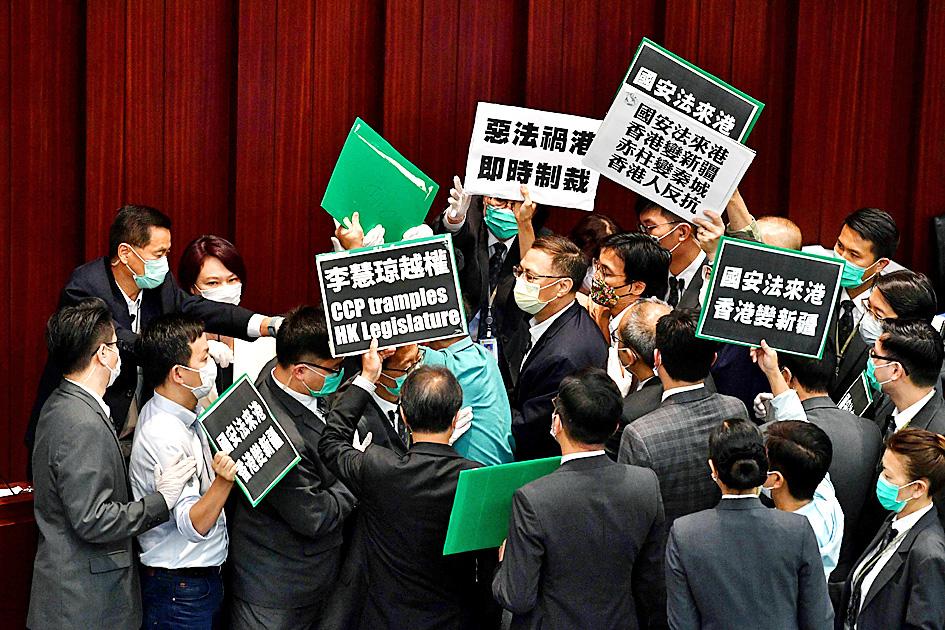Hong Kong pro-democracy campaigners yesterday vowed to take to the streets in protest over what they said was China’s fiercest assault on the territory’s treasured autonomy with its move to impose a security law.
The proposal for the legislation — expected to ban treason, subversion and sedition — was introduced at the opening of the National People’s Congress in Beijing yesterday.
It followed repeated warnings from Chinese leaders that they would no longer tolerate dissent in Hong Kong, which endured seven months of pro-democracy protests last year.

Photo: AFP
“This is the largest nuclear weapon the Chinese Communist Party has used in its mutual destruction of Hong Kong,” said Jimmy Sham (岑子杰), convener of the Civil Human Rights Front, which organized the rally that started last year’s unrest.
Democracy advocate Joshua Wong (黃之鋒) said that China’s message to the protesters was clear.
“Beijing is attempting to silence Hong Kongers’ critical voices with force and fear,” Wong wrote on Twitter, while also expressing defiance. “HKers will not scare off in the face of wolf warrior policy.”
Hong Kong has been allowed a limited form of autonomy since returning from British to Chinese rule in 1997, with those unique freedoms enshrined under a “one country, two systems” agreement.
However, a huge pro-democracy movement has built in the face of fears that China has been steadily eroding those freedoms.
The Chinese Communist Party yesterday made it clear that the planned law was aimed at quashing the democracy movement.
“We must take powerful measures to lawfully prevent, stop and punish them,” National People’s Congress Standing Committee Vice Chairman Wang Chen (王晨) said, referring to “anti-China” forces.
Article 23 of Hong Kong’s Basic Law states that the territory must enact a law to prohibit “treason, secession, sedition [and] subversion” against the Chinese government, but the clause has never been implemented due to opposition from Hong Kongers fearful it would destroy their civil rights.
An attempt to have Article 23 pass the Hong Kong Legislative Council in 2003 was shelved after about 500,000 people took to the streets in protest against it.
China’s move would circumvent the Hong Kong Legislative Council by having it imposed by Beijing.
Wang said Hong Kong’s delays in implementing the security law had forced the Chinese leadership to take action.
“More than 20 years after Hong Kong’s return, however, relevant laws are yet to materialize due to the sabotage and obstruction by those trying to sow trouble in Hong Kong and China at large, as well as external hostile forces,” he said.
The US reacted swiftly, with US Department of State spokeswoman Morgan Ortagus warning that imposing such a law would be “highly destabilizing, and would be met with strong condemnation from the United States and the international community.”

TRAGEDY STRIKES TAIPEI: The suspect died after falling off a building after he threw smoke grenades into Taipei Main Station and went on a killing spree in Zhongshan A 27-year-old suspect allegedly threw smoke grenades in Taipei Main Station and then proceeded to Zhongshan MRT Station in a random killing spree that resulted in the death of the suspect and two other civilians, and seven injured, including one in critical condition, as of press time last night. The suspect, identified as a man surnamed Chang Wen (張文), allegedly began the attack at Taipei Main Station, the Taipei Fire Department said, adding that it received a report at 5:24pm that smoke grenades had been thrown in the station. One man in his 50s was rushed to hospital after a cardiac arrest

SAFETY FIRST: Double the number of police were deployed at the Taipei Marathon, while other cities released plans to bolster public event safety Authorities across Taiwan have stepped up security measures ahead of Christmas and New Year events, following a knife and smoke bomb attack in Taipei on Friday that left four people dead and 11 injured. In a bid to prevent potential copycat incidents, police deployments have been expanded for large gatherings, transport hubs, and other crowded public spaces, according to official statements from police and city authorities. Taipei Mayor Chiang Wan-an (蔣萬安) said the city has “comprehensively raised security readiness” in crowded areas, increased police deployments with armed officers, and intensified patrols during weekends and nighttime hours. For large-scale events, security checkpoints and explosives

A car bomb killed a senior Russian general in southern Moscow yesterday morning, the latest high-profile army figure to be blown up in a blast that came just hours after Russian and Ukrainian delegates held separate talks in Miami on a plan to end the war. Kyiv has not commented on the incident, but Russian investigators said they were probing whether the blast was “linked” to “Ukrainian special forces.” The attack was similar to other assassinations of generals and pro-war figures that have either been claimed, or are widely believed to have been orchestrated, by Ukraine. Russian Lieutenant General Fanil Sarvarov, 56, head

PUBLIC SAFETY: The premier said that security would be tightened in transport hubs, while President Lai commended the public for their bravery The government is to deploy more police, including rapid response units, in crowded public areas to ensure a swift response to any threats, President William Lai (賴清德) said yesterday after a knife attack killed three people and injured 11 in Taipei the previous day. Lai made the remarks following a briefing by the National Police Agency on the progress of the investigation, saying that the attack underscored the importance of cooperation in public security between the central and local governments. The attack unfolded in the early evening on Friday around Taipei Main Station’s M7 exit and later near the Taipei MRT’s Zhongshan